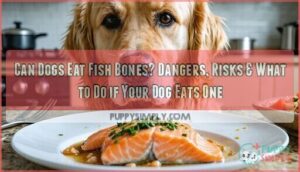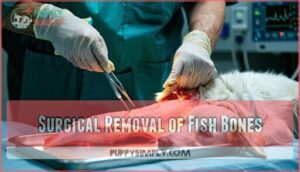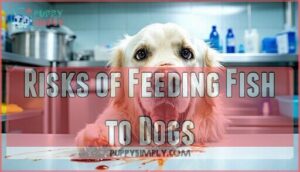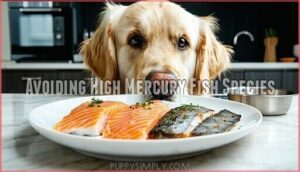This site is supported by our readers. We may earn a commission, at no cost to you, if you purchase through links.
 You’re probably wondering, can dogs eat fish bones?
You’re probably wondering, can dogs eat fish bones?
It’s best to keep those bones far from your furry friend. Fish bones are tiny, sharp, and sneaky—they can poke or get stuck just about anywhere, from gums to the gut.
One chomp and you could be racing to the vet instead of the park. Even if your pup gives you that “just one bite” look, it’s not worth the risk.
Stick to boneless, cooked fish for tail wags and peace of mind. After all, keeping your dog safe is the real catch.
There’s more to know about safe fish treats ahead…
Table Of Contents
- Key Takeaways
- Can Dogs Eat Fish Bones?
- Potential Risks and Problems of Dogs Eating Fish Bones
- Health Benefits of Fish for Dogs
- Risks of Feeding Fish to Dogs
- Best Types of Fish for Dogs
- How to Safely Feed Fish to Dogs
- Frequently Asked Questions (FAQs)
- What happens if a dog eats a fish bone?
- What are the symptoms if a dog eats cooked bones?
- Can dogs gnaw on fish bones?
- Can a dog eat bread if he eats fish bones?
- What happens if a dog eats fish bones?
- Do you have to debone fish for dogs?
- Which bones are safe for dogs to eat?
- Does fish bone good for dogs?
- Can puppies safely consume any type of fish bones?
- Are fish bones in canned fish dangerous for dogs?
- Conclusion
Key Takeaways
- Never let your dog eat fish bones—they’re sharp, brittle, and can cause choking or internal injuries.
- Always pick cooked, boneless fish as a safe treat for your pup and skip the seasonings.
- If your dog accidentally swallows fish bones, watch for signs like vomiting, coughing, or pain, and call your vet right away.
- Keep fish bones out of reach by supervising mealtimes and securing trash to protect your dog’s health.
Can Dogs Eat Fish Bones?
You’re probably wondering if your dog can safely eat fish bones, especially when those puppy eyes beg for a bite.
While it might seem harmless, fish bones are sharp, brittle, and can cause serious health problems for your furry friend.
Fish bones may look harmless, but their sharp edges can quickly turn a treat into a veterinary emergency for your pup.
Signs of Danger and Symptoms to Watch For
Fish bones and curious dogs are a risky combo—like a game of chance you don’t want to play. If your pup sneaks a bite, stay alert for symptoms that spell trouble.
Some warning signs might pop up fast, and others can be easy to overlook in the everyday shuffle. Watch your dog like a hawk if you spot:
- Vomiting or blood in stool—both major red flags
- Coughing, gagging, or pawing at the mouth
- Fever or pale gums (could mean infection or poor blood flow)
- Loss of appetite or not eating and drinking
- Lethargy or signs of abdominal pain
If a bone gets lodged, your dog may experience sharp pain in the throat. If your dog’s mood tanks or you see these symptoms, don’t gamble—call your vet. Safety first keeps tails wagging, and it’s crucial to act quickly to prevent serious issues, ensuring your dog’s well-being and preventing further complications.
What to Do if Your Dog Swallows Fish Bones
So, your dog just gobbled up some fish bones—don’t panic, but don’t brush it off as “just a snack” either.
Stay calm—fish bones aren’t harmless, but quick action keeps your pup out of serious trouble.
Fish bone ingestion is more than a minor slip; it can lead to choking hazards or internal damage.
First, stay calm.
Gently check your dog’s mouth for any visible bones.
If you spot symptoms like gagging, coughing, vomiting, or pawing at the face, that’s your cue to contact your veterinarian right away.
Never try to induce vomiting unless your vet tells you it’s safe.
Sometimes, a little soft food (think plain rice or bread) helps bones pass, but only under a vet’s supervision.
Keep an eye out and monitor symptoms.
In any case, a prompt veterinary examination is the best way to keep your pup out of trouble, as it helps prevent internal damage and ensures your dog’s safety with proper care.
Potential Risks and Problems of Dogs Eating Fish Bones
If your dog snags a fish bone, there’s more at risk than just a little mischief.
Fish bones can cause choking, blockages, or cuts, leaving both you and your pup in a tough spot no one wants to be in.
Puncturing The Digestive Tract
When fish bones slip past a quick sniff and chomp, they can cause havoc down in the gut.
Even a tiny splinter might puncture the intestines, leading to serious problems. Bone size, severity factors, and infection risks all matter.
Watch for:
- Sudden pain or discomfort
- Internal bleeding signs
- Swollen belly or odd posture
- Gastrointestinal risks like organ perforation
Surgical Removal of Fish Bones
After the threat of puncturing the digestive tract comes the need to know when surgical necessity is on the table.
Swallowed bones can cause an intestinal blockage or even peritonitis, which is as dangerous as it sounds.
If your pup shows odd symptoms—like pawing at their face, constant coughing, or bad breath—fish bone ingestion could be the culprit.
That’s when calling a veterinary consultant is a smart move.
Sometimes, less invasive steps aren’t enough, and surgical removal is needed.
The procedure overview includes anesthesia risks and costs that can add up, so be prepared.
Post-op care at home means watching your pet closely for changes in appetite, energy, or comfort.
Early action can mean a smoother road to recovery and fewer worries in your household.
Fish bones are especially dangerous because they easily splinter in dogs.
Preventing Access to Fish Bones
Not every pup is sly enough to open a locked trash can, but why take that gamble? Secure Trash with a lid that even curious noses can’t nudge open—think child safety for your furry friend.
Always Supervise Feeding and use Training Commands like “leave it” if a fish bone hits the floor. Regarding Safe Disposal, bag up leftovers right away.
Fish bone dangers aren’t just old wives’ tales; choking hazards and hidden dog health risks turn fish bones into trouble faster than Rover chasing a squirrel. Fish bones can even puncture the digestive tract, leading to serious complications.
Prioritize dog safety, always, and be aware that fish bones can cause significant harm, making serious complications a real concern.
Health Benefits of Fish for Dogs
Fish can be a healthy part of your dog’s diet, offering protein and omega-3s that support shiny coats and strong bodies.
Just remember, not every pup dreams of being a fish chef—always serve fish safely and skip the bones.
Protein and Omega-3 Fatty Acids
Curious about how to boost your buddy’s nutrition without falling into the fish bones for dogs trap?
While fish bone dangers are real, cooked, boneless fish packs a one-two punch for dog nutrition.
Omega-3 fatty acids help keep your pup’s joints limber and their brain sharp, like oil for squeaky wheels.
Muscle development and immune function get a boost too, making sure your pal stays ready for anything the backyard throws at them.
Pick shorter-lived species, like salmon, since they’re lower in mercury.
Always skip seasonings, especially anything with garlic, and double-check for sneaky bones.
Keeping portions to just a small part of their daily calories helps support coat quality without tipping the scales.
Alternative for Dogs With Food Allergies
Swapping chicken or beef for Hypoallergenic Fish can open new dog food options, especially if your pup scratches more than a DJ at a school dance.
Omega-3 fatty acids found in fish can promote healthy skin and coat.
You’ll want to keep an eye out for allergies—think vomiting or sneezing after mealtime.
Try these steps:
- Use Allergy Testing for peace of mind.
- Try Novel Proteins or Limited Ingredients.
- Explore dog dietary alternatives, like Elimination Diets.
- Consult your vet about safe dog food choices.
- Monitor reactions to all new dog food alternatives.
Risks of Feeding Fish to Dogs
Feeding your dog fish seems healthy, but there are real risks you can’t ignore, from tiny bones to possible allergies.
It’s best to know what can go wrong before sharing your dinner, unless you want an emergency vet visit on your tab.
Raw Fish and Salmon Poisoning Disease
Fish has great perks for your dog, but raw fish bones bring risks you can’t ignore.
Some raw fish carry Neorickettsia helminthoeca, the nasty culprit behind Salmon Poisoning Disease. Your dog gets sick after eating raw fish with this bacteria, usually passed along by tiny parasites called flukes (Fluke Transmission).
Early Symptoms show up quickly—think vomiting, fever, or swollen glands. These signals mean business, so don’t chalk them up to bad kibble.
Fish bones aren’t safe; they’re toxic to dogs and can trigger serious problems fast. The best prevention strategies? Always cook and debone fish, skip feeding raw fish bones, and see your vet quick if you spot trouble—antibiotic treatment saves lives.
Allergic Reactions to Fish
Red flags in a dog’s diet can pop up when you least expect it—like allergic reactions to fish.
If your dog suddenly starts itching, showing hives, or acting differently after eating fish, don’t brush it off.
Identifying allergens is tricky, but pay attention to common allergy symptoms, such as swelling, vomiting, diarrhea, or red, irritated skin.
Some breeds are more at risk; check if your pup’s breed has a known breed predisposition for food allergies.
Diagnostic testing with your vet can help confirm exactly what’s causing the problem.
Managing allergies means removing the troublemakers from your dog’s meals and trying safer alternatives.
Always watch for new dog symptoms when you change up their food and introduce only one new protein at a time.
Allergies don’t play favorites, so even a “safe” food could cause trouble down the road—keep a close eye on your furry friend.
Choosing Safe Fish Species
So, you’ve read about allergic reactions.
Next up: picking safe fish for your dog.
Keep an eye on mercury levels—shorter-lived fish like salmon, herring, and sardines are often your safest bets.
Stay away from big fish with bones for dogs, as their size and mercury can spell trouble.
Always check bone size and go for fish types that are less likely to splinter.
Cook fish well to bust those thiaminase enzymes and kill off parasites—raw vs cooked makes a difference.
Remember that omega-3 fatty acids are highly beneficial for dogs.
Keep things simple, skip the fancy seasonings, and remember: fish treats should only be a small part of your pup’s day.
Always watch for fish allergies.
Best Types of Fish for Dogs
Choosing the right fish for your dog keeps them happy and safe, so it’s smart to pick species that are lower in mercury and easy to prepare.
You don’t want to turn dinner into a trip to the vet, so let’s see what fish actually make the best snack, considering they must be safe.
Safer Fish Species for Dogs
You’ll find quite a few safe fish for dogs if you know where to look.
Soft-boned fish like salmon, whitefish, sardines, and flounder are top picks for both fish bone safety and low mercury levels.
These fish bring powerful fish benefits, including omega-3s and lean protein, but keep an eye out for fish allergies in your dog.
Always check mercury levels, since larger fish—like tuna—can spell trouble if fed too often.
To limit fish risks, offer fish in small portion sizes, keeping treats to about 10% of your dog’s diet.
Safe preparation matters: thoroughly cook fish to nix harmful bacteria.
Choose wisely, stay cautious, and you’ll keep mealtime both tasty and trouble-free.
Preparing Fish for Dogs
Nearly every responsible dog owner wants mealtime to be safe, so pay close attention to fish preparation.
Always go for dog-friendly cooking methods like grilling or steaming to lock in nutrition, not frying with oil or butter.
Bone removal is a must—use your fingers or a fork to check carefully for any fish bones before serving. Don’t risk it with the skin or risky seasonings; keep it simple and safe.
Stick to small serving sizes and refrigerate leftovers promptly for good fish storage. Many owners also choose to buy special fish products designed for canine consumption.
A few minutes spent deboning fish can spare you and your pup a lot of trouble later.
How to Safely Feed Fish to Dogs
If you want your dog to enjoy fish, it’s important to serve it cooked, boneless, and in small portions.
Stick to safe fish types and watch for any signs your pup is more excited than the family cat at dinnertime.
Cooking and Deboning Fish
If you’re choosing safe fish for your pup, the next step is all about proper fish preparation.
Cooking methods like boiling or steaming work well because they keep the fish texture soft and juicy without adding oil or unsafe seasonings.
Always skip the fancy flavors and using safe seasoning means nothing more than a sprinkle of parsley or plain rice alongside.
When the fish cools, grab your bone removal tools—like kitchen tweezers or chopsticks—and get to work deboning fish with patience. Having the right deboning tools is essential for this task.
Fish bones love to hide, so check every nook and cranny. Cut the cooked fish into bite-sized pieces for easy chewing.
Stick to small portion sizes at first, especially if it’s their first time. Watch for any weird reactions after they eat—better safe than sorry!
Avoiding High Mercury Fish Species
Before you toss a chunk of fish into your dog’s bowl, think twice about the type.
Mercury toxicity is no laughing matter—especially for our four-legged friends.
Big fish (like swordfish or shark) soak up more mercury as they age, so steer clear of these giants for daily dog meals.
Instead, pick safe alternatives such as salmon, cod, or whitefish, which keep mercury worries at bay.
Remember, the source matters: buy from trustworthy places to avoid “surprise” contaminants.
Fish bones for dogs spell trouble, but so does mercury.
If you’re ever concerned about fish bones toxic dogs or which species are safest for feeding dogs fish, call your vet.
A smart dog diet always puts safety and moderation first.
Portion Control and Moderation
After picking a safe, low-mercury fish, it’s time to think about portion control and moderation.
Don’t let Daily Fish Intake sneak past the “treat” line—keep fish to less than 10% of their Balanced Diet Inclusion.
Overfeeding Risks can lead to upset bellies or worse, especially for small breeds (Breed Size Matters!).
Fish is a treat, not a meal: one of those common dog feeding mistakes.
Salmon provides key nutrients like omega-3 fatty acids.
Follow dog nutrition tips and avoid raw salmon.
Dog diet concerns?
When in doubt, ask your vet about dog dietary safety to ensure the best for your pet, considering the importance of Daily Fish Intake.
Frequently Asked Questions (FAQs)
What happens if a dog eats a fish bone?
It’s a slippery slope if your dog swallows a fish bone—those sharp bits can get stuck, cause choking, or hurt their throat and belly.
Watch for pain, vomiting, or coughing, and call your vet if worried.
What are the symptoms if a dog eats cooked bones?
If your dog eats cooked bones, you might see drooling, gagging, vomiting, blood in stool, or loss of appetite.
Watch for lethargy or restlessness.
If your pup acts off, call your vet right away.
Can dogs gnaw on fish bones?
Letting your pup gnaw on fish bones is risky business.
Those brittle, sharp bones can splinter, causing mouth injuries, choking, or even digestive trouble.
If you’re aiming for safe chewing, stick to vet-approved dog treats instead.
Can a dog eat bread if he eats fish bones?
Imagine this scenario: your pup just gulped down a fish bone.
Want to help things move along? Bread might act like a gentle broom, wrapping sharp edges as it goes.
Still, it’s wise to call your vet first.
What happens if a dog eats fish bones?
When your pup munches on fish bones, it’s no picnic—bones can splinter, causing cuts or blockages in their mouth or gut.
Watch for vomiting, drooling, or trouble swallowing, and call your vet if things look fishy.
Do you have to debone fish for dogs?
You should always debone fish before serving it to your dog.
Those tiny, sneaky bones can splinter, causing serious mouth or gut troubles.
Play it safe—stick to boneless fish or fillets for a worry-free treat.
Which bones are safe for dogs to eat?
Think of bones like leftover toothpicks—soft, edible fish bones from sardines or salmon are safest for dogs.
Don’t give big, hard, or cooked bones; they splinter easily and could really mess up your dog’s insides.
Does fish bone good for dogs?
Fish bones aren’t good for your dog.
They can splinter and cause choking or hurt your dog’s mouth, throat, or gut.
It’s safer to stick with boneless, cooked fish if you want to treat your dog.
Can puppies safely consume any type of fish bones?
Would you trust a toddler with tiny swords at dinner?
You shouldn’t let puppies eat any kind of fish bones—these sharp shards can choke or injure them.
Stick to boneless fish treats, and your puppy will thank you.
Are fish bones in canned fish dangerous for dogs?
You might spot tiny bones in canned fish, but they’re still a hazard for your dog.
Even soft bones can get stuck, causing pain or choking.
Stick to boneless fish—your pup’s tummy and tail will thank you!
Conclusion
Ever wonder if the stories about fish bones and dogs are true?
Can dogs eat fish bones safely? The answer is simple—they can’t.
Fish bones are risky, causing injuries or even trips to the vet.
Your best move is to choose boneless, cooked fish so your pup can enjoy the benefits without danger.
If your dog finds a bone, watch for trouble and call your vet right away.
Keep fish bones out of paw’s reach for safety.















